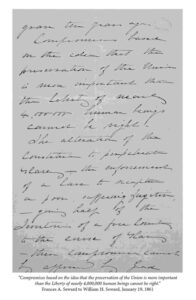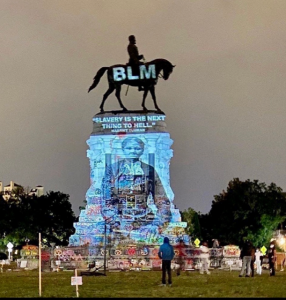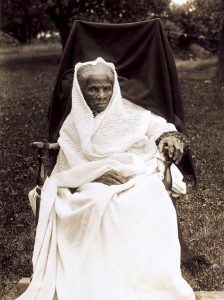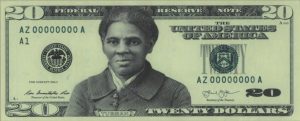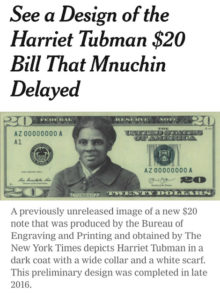Harriet Tubman
Abolition, Women’s Rights & America’s 2nd Revolution
May 7, 2021From the intimate perspective of three friends and neighbors in mid-nineteenth century Auburn, New York—the “agitators” of the title—acclaimed author Dorothy Wickenden tells the fascinating and crucially American stories of abolition, the Underground Railroad, the early women’s rights movement, and the Civil War.
Harriet Tubman was one of the most important conductors on the underground railroad and hid the enslaved men, women and children she rescued in the basement kitchens of Martha Wright, Quaker mother of seven, and Frances Seward, wife of Governor, then Senator, then Secretary of State William H. Seward.
Many of the most prominent figures in the history books—Lincoln, Seward, Daniel Webster, Frederick Douglass, Charles Sumner, John Brown, Harriet Beecher Stowe, William Lloyd Garrison—are seen through the eyes of the protagonists. So are the most explosive political debates: about women’s roles and rights during the abolition crusade, emancipation, and the arming of Black troops; and about the true meaning of the Declaration of Independence and the Constitution.
Beginning two decades before the Civil War, when Harriet Tubman was still enslaved and Martha and Frances were young women bound by law and tradition, The Agitators ends two decades after the war, in a radically changed United States. Wickenden brings this period of our history to life through the richly detailed letters her characters wrote several times a week. Like Doris Kearns Goodwin’s Team of Rivals and David McCullough’s John Adams, Wickenden’s The Agitators is revelatory, riveting, and profoundly relevant to our own time. [Amazon]
The New Yorker Radio Hour
“The Agitators” is a book about three women—three revolutionaries—who changed the world at a time when women weren’t supposed to be in public life at all. Frances Seward was a committed abolitionist who settled with her husband in the small town of Auburn, in western New York. One of their neighbors was a Quaker named Martha Coffin Wright, who helped organize the first convention for women’s rights, at Seneca Falls. Both women harbored fugitives when it was a violation of federal law. And, after they met Harriet Tubman, through the Underground Railroad, Tubman also settled in Auburn. “The Agitators,” by The New Yorker’s executive editor, Dorothy Wickenden, tells their interlocking stories. “These people were outsiders, and they were revolutionaries,” Wickenden tells David Remnick. “They were only two generations separated from the Declaration of Independence, which they believed in literally. They did not understand why women and Black Americans could not have exactly the same rights that had been promised.”
Thomas Merton:
‘You can easily guess that in using the term “innocent bystander” I had to examine my conscience to see whether I was being facetious. I do not remember if I smiled when I first thought of it; but, in any case, I am no longer smiling. For I do nothing the question of our innocence can be a matter for jesting, and I am no longer certain that it is honorable to stand by as the helpless witness to a cataclysm, with no other hope than to die innocently and by accident, as a nonparticipant.’
[Raids one the Unspeakable]
Harriet & Slave Ancestry
December 1, 2020Abolitionist Harriet Tubman (1822-1913) stands with a group of formerly enslaved people she helped lead to freedom. Photo: Bettmann/Getty
AXIOS
A database that gathers records about the lives of enslaved Africans and their descendants is undergoing a massive, crowdsource-powered expansion to unlock Black Americans’ genealogical histories, organizers tell Russell Contreras.
- Why it matters: The initiative, to be unveiled today by Enslaved.org, is the latest to reconstruct lost or incomplete timelines and records from the 1600s-1800s, as the U.S. and other nations reckon with systemic racism.
How it works: The general public and outside researchers can submit family histories, runaway slave ads, or documents of purchase to Enslaved.org.
- Users can search their names and town histories and connect the experiences of enslaved people, from voyages to the changing of names.
First look: Slavery ancestor project expands
Whatthey’resaying: Jessica Ann Mitchell Aiwuyor, founder of the National Black Cultural Information Trust, said African Americans have long sought to reclaim their past amidst hostility.
- “Even after the Civil War, former enslaved people put ads in newspapers looking for lost family members,” she said. “This website is a continuation of that tradition as we look for our past and family but this time in a digital space.
We shouldn’t wait another 10 years to see Harriet Tubman on a $20 bill | Quigley
By Joan Quigley | For The Jersey Journal
This is the year we were supposed to get new $20 bills featuring a portrait of Harriet Tubman. I can’t say it would have been perfect timing because having a woman on American currency was already long overdue, but it sure is a really bad time for a postponement.
[…]
The timing was originally planned to coincide with the 100th anniversary of the 19th Amendment this month, granting women the right to vote. The new bill design was shown in 2011 while Barack Obama was still president, and the bill was supposed to hit banks in March 2020.
But even before he was elected, Trump opposed the idea of taking Andrew Jackson off the twenty. He is one of Trump’s heroes so he proposed putting Tubman on the $2 bill, you know, the one that’s barely in circulation any more. He felt putting her on any bill was “pure political correctness.”
Moreover,
he still supports Jackson, whose racism wasn’t limited to African-Americans but included Native Americans, as well. He recently took strong action to ensure Jackson’s statue remains standing just outside the White House.
Treasury Secretary Steven Mnuchin, almost as soon as he was appointed, agreed to stall. The women’s suffrage anniversary is coming soon with no Tubman twenties.
[…]
Meanwhile, Governor Larry Hogan of Maryland, where Tubman was born, wrote a letter to Mnuchin urging him to speed up the process. Sen. Jeanne Shaheen, D-NH, introduced a bill directing the Treasury to print Tubman’s portrait on all $20 bills starting in 2021.
“The Trump administration’s indefinite postponement of this redesign is offensive to women and girls, and communities of color, who have been excitedly waiting to see this woman and civil rights icon honored in this special way. The needless foot-dragging on this important effort is unacceptable. Our currency tells our country’s story and it is past time to honor the contributions of Harriet Tubman,” Shaheen said.
Symbols do matter. Maybe now more than ever.
Harriet.
March 10, 2020Her hands. ♡
‘Harriet Tubman died on this day…birth year unknown…born and raised in slavery, divined that God wished her to be free. She escaped to freedom, but realized she could not be truly free as long as others were enslaved. So she went back 19 times to “Pharaoh’s Land,” risking death to liberate 300 slaves.’ -Robert Ellsberg, Publisher, Orbis Books
Harriet Tubman 2″ Self Inking Stamp – Perfect for Twenty Dollar Bills
[Available online]
NYTimes, June 2019
“Extensive work was well underway on a new $20 bill bearing the image of Harriet Tubman when Treasury Secretary Steven Mnuchin announced last month that the design of the note would be delayed for technical reasons by six years and might not include the former slave and abolitionist.
Many Americans were deeply disappointed with the delay of the bill, which was to be the first to bear the face of an African-American. The change would push completion of the imagery past President Trump’s time in office, even if he wins a second term, stirring speculation that Mr. Trump had intervened to keep his favorite president, Andrew Jackson, a fellow populist, on the front of the note.”
#HarrietTubmanNow
June 14, 2019NYTIMES
WASHINGTON — Extensive work was well underway on a new $20 bill bearing the image of Harriet Tubman when Treasury Secretary Steven Mnuchin announced last month that the design of the note would be delayed for technical reasons by six years and might not include the former slave and abolitionist.
Many Americans were deeply disappointed with the delay of the bill, which was to be the first to bear the face of an African-American. The change would push completion of the imagery past DT’s time in office, even if he wins a second term, stirring speculation that Mr. Trump had intervened to keep his favorite president, Andrew Jackson, a fellow populist, on the front of the note.
But Mr. Mnuchin, testifying before Congress, said new security features under development made the 2020 design deadline set by the Obama administration impossible to meet, so he punted Tubman’s fate to a future Treasury secretary.
In fact, work on the new $20 note began before DT took office, and the basic design already on paper most likely could have satisfied the goal of unveiling a note bearing Tubman’s likeness on next year’s centennial of the 19th Amendment, which granted women the right to vote.
That preliminary design was completed in late 2016.
A spokeswoman for the bureau, Lydia Washington, confirmed that preliminary designs of the new note were created as part of research that was done after Jacob J. Lew, President Barack Obama’s final Treasury secretary, proposed the idea of a Tubman bill.
The development of the note did not stop there.
A current employee of the bureau, who asked not to be named because of the sensitivity of the matter, personally viewed a metal engraving plate and a digital image of a Tubman $20 bill while it was being reviewed by engravers and Secret Service officials as recently as May 2018. This person said that the design appeared to be far along in the process.
Within the bureau, this person said, there was a sense of excitement and pride about the new $20 note.
But the Treasury Department, which oversees the engraving bureau, decided that a new $20 bill would not be made public next year. Current and former department officials say Mr. Mnuchin chose the delay to avoid the possibility that Mr. Trump would cancel the plan outright and create even more controversy.
In an interview last week, Mr. Mnuchin denied that the reasons for the delay were anything but technical.
“Let me assure you, this speculation that we’ve slowed down the process is just not the case,” Mr. Mnuchin said, speaking on the sidelines of the G-20 finance ministers meeting in Japan.
The Treasury secretary reiterated that security features drive the change of the currency and rejected the notion that political interference was at play. He declined to say if he believed his predecessor had tried to politicize the currency.
Interagency, including the Secret Service and others and B.E.P., that are all career officials that are focused on this,” he said, referring to the Bureau of Engraving and Printing. “They’re working as fast as they can.”
Monica Crowley, a spokeswoman for Mr. Mnuchin, added that the release into circulation of the new $20 note remained on schedule with the bureau’s original timeline of 2030. She did not, however, say that the bill would feature Tubman.
“The scheduled release (printing) of the $20 bill is on a timetable consistent with the previous administration,” she said in a statement.
But building the security features of a new note before designing its images struck some as curious. Larry E. Rolufs, a former director of the Bureau of Engraving and Printing, said that because the security features of a new note are embedded in the imagery, they normally would be created simultaneously.
“It can be done at the same time,” said Mr. Rolufs, who led the bureau from 1995 to 1997. “You want to work them together.”
The process of developing American currency is painstaking, done by engravers who spend a decade training as apprentices. People familiar with the process say that engravers spend months working literally upside down and backward carving the portraits of historical figures into the steel plates that eventually help create cash. Often, multiple engravers will attempt different versions of the portraits, usually based on paintings or photographs, and ultimately, the Treasury secretary chooses which one will appear on a note.
Mr. Rolufs said that because of the complexity of creating new currency, circulating a new note design by next year was ambitious. He also acknowledged that making major changes to the money is an invitation for backlash.
“For the secretary to change the design of the notes takes political courage,” he said. “The American people don’t like their currency messed with.”
As a presidential candidate, Mr. Trump called the decision to replace Jackson, who was a slave owner, with Tubman “pure political correctness.” An overhaul of the Treasury Department’s website after Mr. Trump took office removed any trace of the Obama administration’s plans to change the currency, signaling that the plan might be halted.
Within Mr. Trump’s Treasury Department, some officials complained that Mr. Lew had politicized the currency with the plan and that the process of selecting Tubman, which included an online poll among other forms of feedback, was not rigorous or reflective of the country’s desires.
The uncertainty has renewed interest in the matter. This week, Gov. Larry Hogan of Maryland, where Tubman was born, wrote a letter to Mr. Mnuchin urging him to find a way to speed up the process.
“I hope that you’ll reconsider your decision and instead join our efforts to promptly memorialize Tubman’s life and many achievements,” wrote Mr. Hogan, a Republican.
And last week, a group of House Democrats demanded that the Treasury secretary provide specific information about the security concerns that were impeding the currency redesign.
At the Bureau of Engraving and Printing, which offers tours and an exhibit on the history of the currency, some visitors said they preferred tradition, while others were seeking change.
“For me, it’s not important enough to spend the money to change it,” said Jeff Dunyon, who was visiting Washington from Utah this week. “There are other ways to honor her.”
Charnay Gima, a tourist from Hawaii, had just finished a tour when she pulled aside a guide to ask a question that was bothering her. She wanted to know what became of the plan to make Tubman the face of the $20 bill.
To Ms. Gima’s dismay, there was no sign of Tubman in any of the bureau’s exhibits. The plan was scrapped, she was told, for political reasons.
“It’s kind of sad,” said Ms. Gima, who is black. “I was really looking forward to it because it was finally someone of color on the bill who paved the way for other people.”
Strength & Fairness
December 17, 2018Taking action toward our dreams.
July 11, 2016‘Every great dream begins with a dreamer. Always remember, you have within you the strength, the patience and the passion to reach for the stars to change world.’
-Harriet Tubman
(She escaped slavery to become a leading abolitionist, saving hundreds of lives on the Underground Railroad.)

